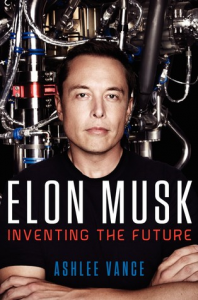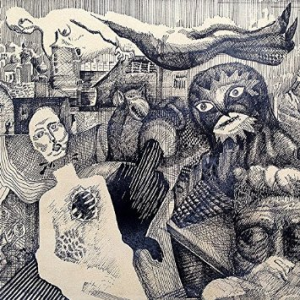
Elon Musk – Inventing the Future
Today I finished reading “Elon Musk: Inventing the Future” by Ashlee Vance
Somebody needs to think about this stuff...
by justin

Elon Musk – Inventing the Future
Today I finished reading “Elon Musk: Inventing the Future” by Ashlee Vance
by justin

Pandora In The Crimson Shell
Today I finished reading “Pandora in the Crimson Shell: Ghost Urn #1” by Masamune Shirow
by justin

This week I am listening to “Art Angels” by Grimes
by justin
A child doing perceived as dangerous activities outdoors?
Or a child swaddled in cotton wool, growing up in front of a TV?
I’d rather have a child with a few broken bones than an adult with a broken mind.
by justin
It’s National No Bra Day.
As I’ve always said, my favourite part of a woman begins with the letter “B” and ends with the letter “S.”
by justin
Today I read a paper titled “Motion model transitions in GPS-IMU sensor fusion for user tracking in augmented reality”
The abstract is:
Finding the position of the user is an important processing step for augmented reality (AR) applications.
This paper investigates the use of different motion models in order to choose the most suitable one, and eventually reduce the Kalman filter errors in sensor fusion for such applications where the accuracy of user tracking is crucial.
A Deterministic Finite Automaton (DFA) was employed using the innovation parameters of the filter.
Results show that the approach presented here reduces the filter error compared to a static model and prevents filter divergence.
The approach was tested on a simple AR game in order to justify the accuracy and performance of the algorithm.
by justin

Performing Flea
Today I finished reading “Performing Flea” by P.G. Wodehouse
by justin

This week I am listening to “Panda Bear Meets The Grim Reaper” by Panda Bear
by justin
This month I am studying “Baking Mastery – European cakes and tortes”
48 months part-time. 31st month. Taking it slow, not sure about the techniques.
by justin

This week I am listening to “Drones” by Muse
by justin

Pieces #1
Today I finished reading “Pieces 1: Premium Gallery” by Masamune Shirow
by justin
Today I read a paper titled “Formal Verification of Autonomous Vehicle Platooning”
The abstract is:
The coordination of multiple autonomous vehicles into convoys or platoons is expected on our highways in the near future.
However, before such platoons can be deployed, the new autonomous behaviors of the vehicles in these platoons must be certified.
An appropriate representation for vehicle platooning is as a multi-agent system in which each agent captures the “autonomous decisions” carried out by each vehicle.
In order to ensure that these autonomous decision-making agents in vehicle platoons never violate safety requirements, we use formal verification.
However, as the formal verification technique used to verify the agent code does not scale to the full system and as the global verification technique does not capture the essential verification of autonomous behavior, we use a combination of the two approaches.
This mixed strategy allows us to verify safety requirements not only of a model of the system, but of the actual agent code used to program the autonomous vehicles.
by justin
Today I read a paper titled “RFID Technology Based Attendance Management System”
The abstract is:
RFID is a nascent technology, deeply rooted by its early developments in using radar1 as a harbinger of adversary planes during World War II.
A plethora of industries have leveraged the benefits of RFID technology for enhancements in sectors like military, sports, security, airline, animal farms, healthcare and other areas.
Industry specific key applications of this technology include vehicle tracking, automated inventory management, animal monitoring, secure store checkouts, supply chain management, automatic payment, sport timing technologies, etc.
This paper introduces the distinctive components of RFID technology and focuses on its core competencies: scalability and security.
It will be then supplemented by a detailed synopsis of an investigation conducted to test the feasibility and practicality of RFID technology.
by justin
Today I read a paper titled “Faster Quantum Number Factoring via Circuit Synthesis”
The abstract is:
A major obstacle to implementing Shor’s quantum number-factoring algorithm is the large size of modular-exponentiation circuits.
We reduce this bottleneck by customizing reversible circuits for modular multiplication to individual runs of Shor’s algorithm.
Our circuit-synthesis procedure exploits spectral properties of multiplication operators and constructs optimized circuits from the traces of the execution of an appropriate GCD algorithm.
Empirically, gate counts are reduced by 4-5 times, and circuit latency is reduced by larger factors.
by justin
Today I read a paper titled “Autonomously Learning to Visually Detect Where Manipulation Will Succeed”
The abstract is:
Visual features can help predict if a manipulation behavior will succeed at a given location.
For example, the success of a behavior that flips light switches depends on the location of the switch.
Within this paper, we present methods that enable a mobile manipulator to autonomously learn a function that takes an RGB image and a registered 3D point cloud as input and returns a 3D location at which a manipulation behavior is likely to succeed.
Given a pair of manipulation behaviors that can change the state of the world between two sets (e.g., light switch up and light switch down), classifiers that detect when each behavior has been successful, and an initial hint as to where one of the behaviors will be successful, the robot autonomously trains a pair of support vector machine (SVM) classifiers by trying out the behaviors at locations in the world and observing the results.
When an image feature vector associated with a 3D location is provided as input to one of the SVMs, the SVM predicts if the associated manipulation behavior will be successful at the 3D location.
To evaluate our approach, we performed experiments with a PR2 robot from Willow Garage in a simulated home using behaviors that flip a light switch, push a rocker-type light switch, and operate a drawer.
By using active learning, the robot efficiently learned SVMs that enabled it to consistently succeed at these tasks.
After training, the robot also continued to learn in order to adapt in the event of failure.
by justin

Cocktail Time
Today I finished reading “Cocktail Time” by P.G. Wodehouse
by justin
Today I finished reading “Perfect Phrases for Documenting Employee Performance Problems” by Anne Bruce
by justin
Today I read a paper titled “Brain4Cars: Car That Knows Before You Do via Sensory-Fusion Deep Learning Architecture”
The abstract is:
Advanced Driver Assistance Systems (ADAS) have made driving safer over the last decade.
They prepare vehicles for unsafe road conditions and alert drivers if they perform a dangerous maneuver.
However, many accidents are unavoidable because by the time drivers are alerted, it is already too late.
Anticipating maneuvers beforehand can alert drivers before they perform the maneuver and also give ADAS more time to avoid or prepare for the danger.
In this work we propose a vehicular sensor-rich platform and learning algorithms for maneuver anticipation.
For this purpose we equip a car with cameras, Global Positioning System (GPS), and a computing device to capture the driving context from both inside and outside of the car.
In order to anticipate maneuvers, we propose a sensory-fusion deep learning architecture which jointly learns to anticipate and fuse multiple sensory streams.
Our architecture consists of Recurrent Neural Networks (RNNs) that use Long Short-Term Memory (LSTM) units to capture long temporal dependencies.
We propose a novel training procedure which allows the network to predict the future given only a partial temporal context.
We introduce a diverse data set with 1180 miles of natural freeway and city driving, and show that we can anticipate maneuvers 3.5 seconds before they occur in real-time with a precision and recall of 90.5\% and 87.4\% respectively.
by justin
Today I read a paper titled “Lift-off dynamics in a simple jumping robot”
The abstract is:
We study vertical jumping in a simple robot comprising an actuated mass-spring arrangement.
The actuator frequency and phase are systematically varied to find optimal performance.
Optimal jumps occur above and below (but not at) the robot’s resonant frequency $f_0$.
Two distinct jumping modes emerge: a simple jump which is optimal above $f_0$ is achievable with a squat maneuver, and a peculiar stutter jump which is optimal below $f_0$ is generated with a counter-movement.
A simple dynamical model reveals how optimal lift-off results from non-resonant transient dynamics.
by justin

This week I am listening to “Pale Horses” by mewithoutyou
by justin
Making use of mostly off-the-shelf components (I’m not proud) I built a new cat toy last week that keeps my cats entertained for hours.
I’ve had to add in code that limits how much time the cats can play with it for so that they don’t wear themselves out.
I have some ideas on how to improve the toy, mostly to do with vision recognition and feline detection.
The robot is a 3-axis arm controlled by servos and a simple driver circuit that plugs in to either a microcontroller or laptop.
Right now I am using a Microsoft Surface but will switch over to a Raspberry Pi 3 once I get the code working how I want it to.
by justin
Today I finished reading “Pearls Gets Sacrificed: A Pearls Before Swine Treasury” by Stephan Pastis
by justin
Today I read a paper titled “Mathematical Analysis of Multi-Agent Systems”
The abstract is:
We review existing approaches to mathematical modeling and analysis of multi-agent systems in which complex collective behavior arises out of local interactions between many simple agents.
Though the behavior of an individual agent can be considered to be stochastic and unpredictable, the collective behavior of such systems can have a simple probabilistic description.
We show that a class of mathematical models that describe the dynamics of collective behavior of multi-agent systems can be written down from the details of the individual agent controller.
The models are valid for Markov or memoryless agents, in which each agents future state depends only on its present state and not any of the past states.
We illustrate the approach by analyzing in detail applications from the robotics domain: collaboration and foraging in groups of robots.
by justin
I need to figure out how to get my Kinect to recognise and process the input from the paws of a feline.
To put this in context, my wife won’t let me re-purpose one of the huge touch screen computers we have as an interactive cat toy.
*grumble* *grumble* *grumble*
So now I need to see if there is any research that has been done on recognising touch input from a feline using the Microsoft Kinect and then figure out how to do that myself.
Life would be so much easier if my wife didn’t give me “that look” every time I wanted to experiment with my cats.
by justin
My cat (yes, my cat), has reached a point in her life where she thinks that all computer screens are now touch screens and can be appropriately interacted with.
She will paw at the screen and “ask for her game” and then wonder why it doesn’t respond how it does on the big, touch screen monitors she normally plays on.
Perhaps I am anthropomorphizing her reactions a bit.
But there is definitely a posture of confusion, possibly even disappointment, when trying to play her game.
My wife does this on a daily basis when she tries clicking on my Mac Book Pro’s screen.
by justin
Today I finished reading “Lord Emsworth Acts for the Best” by P.G. Wodehouse
by justin
The greatest gift you can give yourself is to live a life that is true to yourself rather than one that others expect of you.
by justin
Today I read a paper titled “Progressive Compression of 3D Objects with an Adaptive Quantization”
The abstract is:
This paper presents a new progressive compression method for triangular meshes.
This method, in fact, is based on a schema of irregular multi-resolution analysis and is centered on the optimization of the rate-distortion trade-off.
The quantization precision is adapted to each vertex during the encoding / decoding process to optimize the rate-distortion compromise.
The Optimization of the treated mesh geometry improves the approximation quality and the compression ratio at each level of resolution.
The experimental results show that the proposed algorithm gives competitive results compared to the previous works dealing with the rate-distortion compromise.
by justin

This week I am listening to “How Big, How Blue, How Beautiful” by Florence And The Machine
by justin
Today I read a paper titled “Intent expression using eye robot for mascot robot system”
The abstract is:
An intent expression system using eye robots is proposed for a mascot robot system from a viewpoint of humatronics.
The eye robot aims at providing a basic interface method for an information terminal robot system.
To achieve better understanding of the displayed information, the importance and the degree of certainty of the information should be communicated along with the main content.
The proposed intent expression system aims at conveying this additional information using the eye robot system.
Eye motions are represented as the states in a pleasure-arousal space model.
Changes in the model state are calculated by fuzzy inference according to the importance and degree of certainty of the displayed information.
These changes influence the arousal-sleep coordinates in the space that corresponds to levels of liveliness during communication.
The eye robot provides a basic interface for the mascot robot system that is easy to be understood as an information terminal for home environments in a humatronics society.
by justin
Today I finished reading “Irrationally yours : on missing socks, pick-up lines and other existential puzzles” by Dan Ariely
by justin
Today I read a paper titled “Real-time Automatic Emotion Recognition from Body Gestures”
The abstract is:
Although psychological research indicates that bodily expressions convey important affective information, to date research in emotion recognition focused mainly on facial expression or voice analysis.
In this paper we propose an approach to realtime automatic emotion recognition from body movements.
A set of postural, kinematic, and geometrical features are extracted from sequences 3D skeletons and fed to a multi-class SVM classifier.
The proposed method has been assessed on data acquired through two different systems: a professionalgrade optical motion capture system, and Microsoft Kinect.
The system has been assessed on a “six emotions” recognition problem, and using a leave-one-subject-out cross validation strategy, reached an overall recognition rate of 61.3% which is very close to the recognition rate of 61.9% obtained by human observers.
To provide further testing of the system, two games were developed, where one or two users have to interact to understand and express emotions with their body.
by justin
Today I finished reading “Conan, Volume 12: Throne of Aquilonia” by Roy Thomas
by justin
I believe there is a strong correlation between people who don’t pay attention in school and negative Amazon reviews.
Reading the reviews of magnets on Amazon is enlightening because what goes through my mind is “Magnets! How do they fucking work?!?”
I weep the for human race when someone applies a magnet to a “magnetic surface” like the thin metal wall of a refrigerator with a slick surface and then complain that the magnet cannot hold the rated weight. Or any weight.
I understand that not everyone is mechanically minded and the world is a complex and fascinating place of seeming juxtapositions but if you do not understand that magnets are stronger in one direction, and require something to adhere to that has substance, but weak in the sliding/shearing direction, or weak when sat on a thin ferrous metal surface, or don’t work at all with non-ferrous metals, then I can only conclude that you were not paying attention in science class in school because it is “boring.”
Also, if you had told me 30 years ago that hundreds of people would…
1. Leave detailed reviews, with explanatory pictures, of refrigerator magnets
2. Have people refute or support those reviews with further details and pictures and diagrams
3. Argue over the subtleties of the different types of magnets
4. And have a customer service representative answer questions about how to properly use the magnets
…I would have told you to put down the hash pipe and come back to the real world.
And yet, here we are.
Not only with glowing or damning reviews about a pack of magnets costing a few dollars, but me, thinking long and hard about the human condition of people who write reviews about magnets.
by justin

This week I am listening to “Short Movie” by Laura Marling
by justin
At the start of 2016 we had 9 computers (laptops/desktops) in the family household, 8 of them running Windows.
We are now up to 12 computers but down to only 4 installations of Windows.
By the end of this year, it will probably be only one, maybe two installations of Windows due to a desire to play certain games.
When you are in business and you act like an arrogant prick towards your customers, they vote with their dollars.
I fully expect Microsoft to go through the same shit they did in the 90’s with the anti-trust and wrist slapping because some companies are just pathological in their abusive practices.
Eventually you give up trying to teach the dog not to shit in the house using positive reinforcement and instead resort to negative reinforcement.
by justin
Today I read a paper titled “A Low Cost Vision Based Hybrid Fiducial Mark Tracking Technique for Mobile Industrial Robots”
The abstract is:
The field of robotic vision is developing rapidly.
Robots can react intelligently and provide assistance to user activities through sentient computing.
Since industrial applications pose complex requirements that cannot be handled by humans, an efficient low cost and robust technique is required for the tracking of mobile industrial robots.
The existing sensor based techniques for mobile robot tracking are expensive and complex to deploy, configure and maintain.
Also some of them demand dedicated and often expensive hardware.
This paper presents a low cost vision based technique called Hybrid Fiducial Mark Tracking (HFMT) technique for tracking mobile industrial robot.
HFMT technique requires off-the-shelf hardware (CCD cameras) and printable 2-D circular marks used as fiducials for tracking a mobile industrial robot on a pre-defined path.
This proposed technique allows the robot to track on a predefined path by using fiducials for the detection of Right and Left turns on the path and White Strip for tracking the path.
The HFMT technique is implemented and tested on an indoor mobile robot at our laboratory.
Experimental results from robot navigating in real environments have confirmed that our approach is simple and robust and can be adopted in any hostile industrial environment where humans are unable to work.
by justin
Today I finished reading “The Walking Dead, Book Eleven” by Robert Kirkman
by justin
Today I finished reading “Uneasy Money” by P.G. Wodehouse
by justin
This month I am studying “Baking Mastery – European cakes and tortes”
48 months part-time. This is the 29th month and 30th month
by justin

This week I am listening to “Pageant Material” by Kacey Musgraves
by justin
Today I read a paper titled “Brain Computer Interface Technologies in the Coming Decades”
The abstract is:
As the proliferation of technology dramatically infiltrates all aspects of modern life, in many ways the world is becoming so dynamic and complex that technological capabilities are overwhelming human capabilities to optimally interact with and leverage those technologies.
Fortunately, these technological advancements have also driven an explosion of neuroscience research over the past several decades, presenting engineers with a remarkable opportunity to design and develop flexible and adaptive brain-based neurotechnologies that integrate with and capitalize on human capabilities and limitations to improve human-system interactions.
Major forerunners of this conception are brain-computer interfaces (BCIs), which to this point have been largely focused on improving the quality of life for particular clinical populations and include, for example, applications for advanced communications with paralyzed or locked in patients as well as the direct control of prostheses and wheelchairs.
Near-term applications are envisioned that are primarily task oriented and are targeted to avoid the most difficult obstacles to development.
In the farther term, a holistic approach to BCIs will enable a broad range of task-oriented and opportunistic applications by leveraging pervasive technologies and advanced analytical approaches to sense and merge critical brain, behavioral, task, and environmental information.
Communications and other applications that are envisioned to be broadly impacted by BCIs are highlighted; however, these represent just a small sample of the potential of these technologies.
by justin
Today I finished reading “Natural Language Processing with Python” by Steven Bird
by justin
Today I finished reading “Hot Water” by P.G. Wodehouse
by justin
Today I finished reading “I Can’t Remember if We’re Cheap or Smart” by Scott Adams
by justin

Principal motion components for gesture recognition using a single-example
Today I read a paper titled “Principal motion components for gesture recognition using a single-example”
The abstract is:
This paper introduces principal motion components (PMC), a new method for one-shot gesture recognition. In the considered scenario a single training-video is available for each gesture to be recognized, which limits the application of traditional techniques (e.g., HMMs). In PMC, a 2D map of motion energy is obtained per each pair of consecutive frames in a video. Motion maps associated to a video are processed to obtain a PCA model, which is used for recognition under a reconstruction-error approach. The main benefits of the proposed approach are its simplicity, easiness of implementation, competitive performance and efficiency. We report experimental results in one-shot gesture recognition using the ChaLearn Gesture Dataset; a benchmark comprising more than 50,000 gestures, recorded as both RGB and depth video with a Kinect camera. Results obtained with PMC are competitive with alternative methods proposed for the same data set.
by justin

This week I am listening to “Complicated Game” by James McMurtry
by justin
Today I finished reading “The Power Laws: The Science Of Success” by Richard Koch
by justin
Today I finished reading “Breaking Stephan: A Pearls Before Swine Collection” by Stephan Pastis
by justin
Today I finished reading “Your New Job Title is “Accomplice”” by Scott Adams